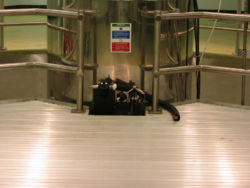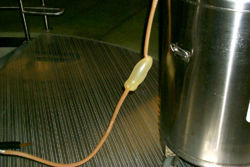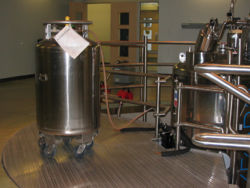NANUC Nitrogen Filling Procedure
From NMR Wiki
Liquid Nitrogen Filling Procedure
System Description:
The NANUC 800 MHz magnet system has a 180 L LN2 reservoir which is topped up every week on Tuesdays. The regular volume of LN2 used for this system is 99 L.

|
1. Remove all magnetically sensitive items from pockets and store in a suitable area.
2. Confirm that the spectrometer system is idle by observing the ‘acquitision’ LED on the remote status unit. The aquisition LED should remain off if the system is idle. If the system is not idle contact the current user.
3. Observe and record the helium boil-off rate from the top helium bath and also observe the rate at which helium is pumped through the high vacuum pumps and record the values on the data sheets provided.
Note: At NANUC data collection for all system parameters is done at the same time as liquid nitrogen filling.
4. Move the nitrogen dewar into the NMR room and place it in front of the nitrogen port which is half way down the cyostat body on the Oxford 800 MHz magnet. Attach the filling tube to the LN2 dewar with non-magnetic wrench.

|
5. Remove the 2 psi check valve on the first nitrogen vent port and place on an insulated venting tube similar to the one permanently installed on the second vent port.
6. Remove the central ‘top hat’ connector and store on back shelf. Insert LN2 filling tube until resistance is met. Lift the tube about 2 cm up from it’s stopping point to ensure non-obstructed LN2 flow.
Note: The Oxford 800 MHz cryostat fills and vents N2 from the same port and can therefore not be filled at a fast rate. If the the filling rate is too high LN2 will prematurely be exhausted from the vent ports. Excessively high filling pressure may also blow up the fill tube prior to freezing. The dewar pressure can be no more than 10 psi.
7. The tubes will shorten during filling, so ensure there is adequate tube length to allow for a slight shortening during filling.

|
Note: Be sure all fill and exhaust tubing is NOT obstructed or kinked.
8. Open the liquid valve slowly, and the filling tubes will freeze and become rigid.
9. Confirm unrestricted gas flow from both venting tubes. As the liquid nitrogen flows through the filling tube, the tube will vibrate.
Note: Be sure extreme vibration does not fracture the filling tube. If at any time the filling tube ruptures quickly turn off the liquid valve.
10. When liquid appears through the venting tubes the nitrogen bath is full. Appearance of liquid nitrogen is characterized with increased oscillation of the venting tube coupled with an audible spurting sound. Turn off the liquid valve and allow the tubes to thaw for at least 2 minutes.
11. Wipe up all condensed water from the magnet. Do not rock or oscillate the magnet excessively.

